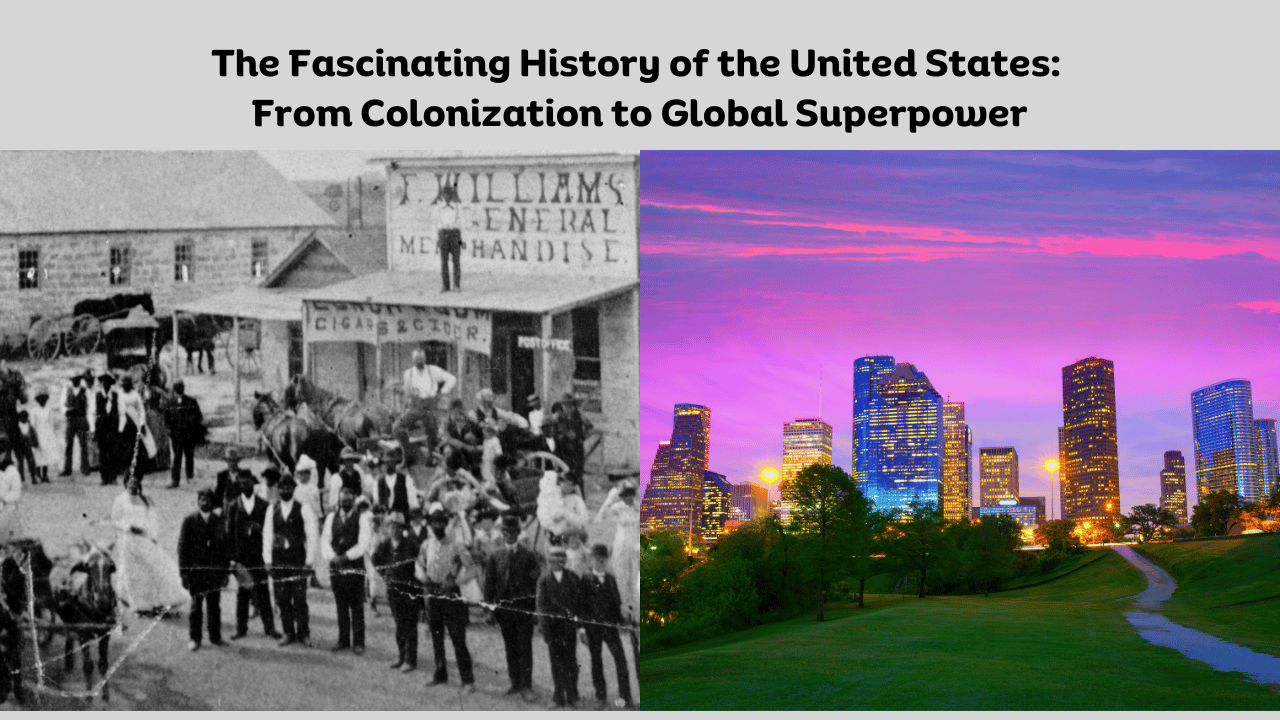The history of the United States is a captivating journey that spans a vast timeframe, starting from the time when the first settlers arrived in the Americas approximately 15,000 BC. This article explores “the remarkable story of the United States, tracing its origins from the ancient indigenous cultures to its emergence as a dominant global superpower.
Indigenous Cultures and European Colonization
The United States’ history is rooted in the rich tapestry of indigenous cultures that thrived across the land. In the 16th century, these societies underwent transformations, transitioning from densely populated lifestyles to reorganized politics in various regions.
The European expansion into the Americas commenced in the late 15th century, but the establishment of the colonies that eventually became the United States primarily took place after 1600. Around the 1760s, the British colonies situated along the Atlantic Coast, to the east of the Appalachian Mountains, accommodated a population of 2.5 million individuals. Notably, the Southern Colonies adopted an agricultural system that heavily relied on enslaved labor, with enslaved individuals being brought from Africa.
Struggles for Independence and the Birth of a Nation
Tensions between the British government and the American colonies escalated in the 18th century. The imposition of taxes, such as the Stamp Act of 1765, without the colonists’ consent led to resistance. Events like the Boston Tea Party in 1773 intensified the conflict. In 1775, armed conflict broke out in Massachusetts, marking the beginning of the Revolutionary War.
Subsequently, the Second Continental Congress assembled in Philadelphia in 1776 and formally proclaimed the independence of the colonies, establishing the foundation for the formation of the “United States.” Under the leadership of General George Washington, the American forces achieved significant victories in the Revolutionary War. Finally, in 1783, the peace treaty was signed, delineating the borders of the new nation.
Formation of a Strong Central Government and Westward Expansion
The Articles of Confederation, initially established as the central government, proved ineffective. In 1789, a new Constitution was adopted, with the addition of the Bill of Rights in 1791 to safeguard essential rights. Under the leadership of President George Washington and his adviser Alexander Hamilton, a robust central government took shape. In 1803, the Louisiana Territory was acquired from France, doubling the size of the USA.
Motivated by the idea of manifest destiny, the United States pursued westward expansion and eventually reached the Pacific Coast. Although the country possessed a large territory, its population was relatively small in 1790. Nonetheless, the promise of inexpensive land attracted both yeoman farmers and slaveholders. The expansion of slavery became a contentious issue, leading to heated debates and the necessity for compromises.
Civil War, Emancipation, and Reconstruction
In the year 1860, the issue of slavery reached a critical stage, causing significant tensions. As a result, the southern states decided to withdraw from the Union, leading to the outbreak of the Civil War and the establishment of the Confederate States of America. Ultimately, the Union emerged victorious in 1865, leading to the abolition of slavery. Subsequently, during the Reconstruction era, efforts were made to extend voting and legal rights to freed male slaves, thereby reinforcing the federal government’s role in safeguarding individual rights.
Rise of Industrial Power and Progressive Reforms
During the early 1900s, the United States emerged as a dominant force in industrialization, with entrepreneurship and a surge of immigrant laborers and farmers driving its growth. The Progressive movement, spanning from the 1890s to the 1920s, introduced notable changes aimed at societal improvement. These reforms encompassed the implementation of a federal income tax, the direct election of Senators, enacting alcohol prohibition, granting citizenship to indigenous people, and securing women’s right to vote.
World Wars, Cold War, and Civil Rights Movement
During both World Wars, the United States played significant roles by supporting the Allies and employing nuclear weapons to bring an end to the Pacific War. Following World War II, the Soviet Union and the United States emerged as rival superpowers, marking the beginning of the Cold War era. This period was characterized by indirect confrontations, including the arms race and proxy wars, between the two nations. In the 1960s, the civil rights movement gained traction, resulting in notable social reforms that ensured African Americans’ voting rights and freedom of movement.
Modern Challenges and Global Influence
Following the collapse of the Soviet Union, the United States emerged as the singular global superpower. In the post-Cold War period, American foreign policy underwent a transition, with increased attention directed towards Middle Eastern conflicts, particularly after the occurrence of the September 11 attacks. During the early years of the 21st century, the United States confronted notable hurdles, including the Great Recession and the far-reaching effects of the COVID-19 pandemic. These challenges posed significant tests to the nation’s resilience and ability to adapt, impacting the local economy and society at large.”
Conclusion
The history of the United States is a testament to its evolution from a group of colonies to a global powerhouse. It encompasses struggles for independence, territorial expansion, the abolition of slavery, periods of reform and progress, and the ongoing pursuit of equality and prosperity. Understanding this rich and complex history provides valuable insights into the nation’s identity and its enduring pursuit of the American dream.
As the United States continues to navigate the challenges of the present and shape its future, it is essential to recognize the lessons learned from the past. The fascinating history of the United States serves as a foundation for building a more inclusive, resilient, and prosperous society for generations to come.
Reference
Wikipedia. (n.d.). History of the United States. Retrieved June 15, 2023, from https://en.wikipedia.org/wiki/History_of_the_United_States
Britannica. (n.d.). United States. Retrieved June 15, 2023, from https://www.britannica.com/place/United-States





3 Comments on “The Fascinating History of the United States: From Colonization to Global Superpower”